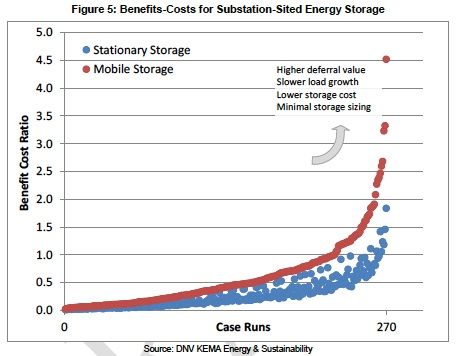Grid-scale batteries -- are they worth it?
That seemingly simple question is in fact incredibly hard to answer. To be sure, batteries can serve a whole variety of functions with value to the utilities or the end customers paying for them, from stabilizing local grid instabilities or providing emergency backup power, to shifting whole blocks of power from hour to hour or day to day to better utilize the mix of traditional and renewable generation resources that make up modern grids.
But whether these still-expensive batteries can do these jobs cost-effectively compared to other resources, like gas-fired peaker plants or demand response assets, remains an open question -- and one that really requires each application to be studied on a case-by-case basis.
That’s the goal of energy consultancy DNV KEMA’s new ES-GRID software, a tool that applies sub-second grid modeling and simulation to the task of quantifying the value of energy storage for specific purposes. Recently, ES-GRID has had a chance to test its capabilities on a truly daunting energy storage valuation problem -- how the California Public Utilities Commission (CPUC) should set up a regulatory and market system for pushing an unprecedented 1.3 gigawatts of energy storage onto the state’s grid by decade’s end.
I recently spoke with Rick Fioravanti, vice president of distributed energy resources for DNV KEMA, about how the CPUC has used ES-GRID to test the proposition of several specific energy storage applications for the grid. A draft report [PDF] of the project is available, and will be part of the CPUC’s process to set up its energy storage mandate, including its groundbreaking attempt to quantify cost-effectiveness of storage systems across the spectrum of grid needs.
“There are literally over 670 megawatts of these advanced batteries out in the field today” around the world, Fioravanti said. “And yet, you can see, as quickly as things are moving in some cases, we’re not talking about purely commercialized systems.” Instead, energy storage systems in the field today are mostly government-funded R&D projects, or ones built by a single owner to serve a single, well-defined purpose.
In the meantime, the tools available to assess energy storage for multiple purposes and multiple customer benefits have been centered on “very general, dollar-per-kilowatt benefits,” he said. “We knew we needed a simulation tool, that it would have to be customized for various utilities, that it would have to be interoperable with various simulation tools that were available,” he said.
Smart-Sized Solar Smoothing, Mobile Batteries for Asset Deferral
Take the first storage applications that DNV KEMA tested out for the CPUC – the value of batteries to integrate intermittent solar power into a local distribution grid.
“We knew what solar would do on the feeder, we knew what activities would be detrimental to the system. We put storage in and ran a number of simulations to see if the storage device being there, and being discharged correctly, would mitigate any of these issues.”
From there, “We quantified that financially, to see what the benefit would be.” The results, as shown by this scatter-plot graph of a simulation of 250 different use cases, indicates just how tricky it is to find the best fit:

Out of the 250 use cases studied, roughly 200 of them fell below the 1.0 benefit-to-cost ratio that indicates where a system is worth more than it costs over its lifespan. In other words, most of the simulated use cases ended up not being worth it.
At the same time, the 50 or so use cases that did show cost effectiveness were able to achieve fairly high rankings, some approaching a three-to-one benefit-cost ratio. What made an individual (simulated) deployment worth it, in turn, largely depended on a combination of costs and benefits aligning properly. On the cost side, the most beneficial use cases combined cost-effective battery technologies, along with a properly sized system -- not too much battery for the job, but not too little, either.
On the benefit side, the positive use cases were in places with the highest costs for fixing distribution lines to manage the addition of solar power. In fact, “Upgrade avoidance, including re-conductoring and avoided regulator costs, accounted for the majority of benefit value,” the draft report found. In other words, the best values weren’t derived from cheaper or better batteries, but from choosing the right places to deploy them.
A similar set of findings emerged from DNV Kema’s simulation of another core use case -- installing batteries in places where utilities would otherwise have to add new power lines to manage peak demands. That’s called “asset deferral,” and it accounts for a significant portion of the grid batteries deployed today.
But asset deferral can be a very tricky business proposition, due to the fact that batteries can’t defer the need for upgrades forever -- only for a certain number of years. In fact, if that effective asset deferral period is shorter than the effective lifespan of the batteries, that could yield the whole purpose for having the batteries there in the first place moot long before they’ve had a chance to pay for themselves -- unless, that is, the batteries are built to be able to be moved from site to site as the need occurs.

This graph shows clearly how mobile batteries can serve a greater number of positive benefit-cost ratio use cases than can stationary batteries. Of course, not all battery technologies lend themselves to being moved from place to place, and the costs of disconnecting and reconnecting them several times over their expected lifespan can add complications that add to cost.
Opening Up the Energy Storage Cost-Benefit Equation
“In each case, we certainly weren’t seeing, say, 90 percent of all the cases being positive,” he noted. “Frankly, it was the other way around -- we were seeing a relatively low batting average. But we’re still finding places where, if the price went down, or some of the numbers were adjusted here, that it was showing positive results.”
Fioravanti was quick to add that these results didn’t take into account every single benefit that these simulated deployments could yield. For example, neither the solar integration nor the asset deferral studies took account of “improved power quality potential and potential improvements to system reliability,” according to the draft report -- two factors that would require a whole new set of calculations that applied local benefits to a grid-wide context.
Nor did these studies try to tackle the question of when batteries can perform multiple value-adding functions at once, he added -- although that’s certainly part of what ES-GRID is designed to do, in terms of filling in the gaps left by other cost-benefit methodologies.
“Some of these tools weren’t capturing the multiple benefits of these storage systems,” he said. “People were just looking at it as a single application -- can it do this, can it do that. You can’t just add three discrete analyses together. There may be overlaps, there may be times that the device gets discharged to do one thing, and just can’t do the other.”
DNV KEMA is now working with the Department of Energy’s Pacific Northwest National Laboratory (PNNL) on a project to effectively calculate those variables, he said. Part of doing that essentially involves breaking down simulation models to the sub-second level of detail that ES-GRID allows, but which other modeling techniques may not capture, he noted.
In the meantime, we’ve seen lots of software tools emerging to manage the interaction of energy storage systems with the grid, ranging from optimizing operations at battery-systems level to playing energy storage into energy markets at a grand scale. What remains unclear, Fioravanti noted, is how to develop the regulatory and economic models that allow for a single storage device to serve multiple functions for multiple parties, whether they be utilities and their customers, or utilities and the merchant power generators that supply them with power.
“If there are ways for both sides to share the single device, that’s when the multi-scenario analysis shows you have a no-brainer set of applications,” he said. “But we just don’t have the regulations that allow us to do that yet.” Indeed, the CPUC’s energy storage mandate may be among the first attempts to set rules for this kind of cost and benefit-sharing.
This week’s Energy Storage North America conference in San Jose, Calif., where Fioravanti and others will be speaking on this subject, will be a good place to look for updates on how that’s going to take shape -- stay tuned for more reporting on the subject later this week.



